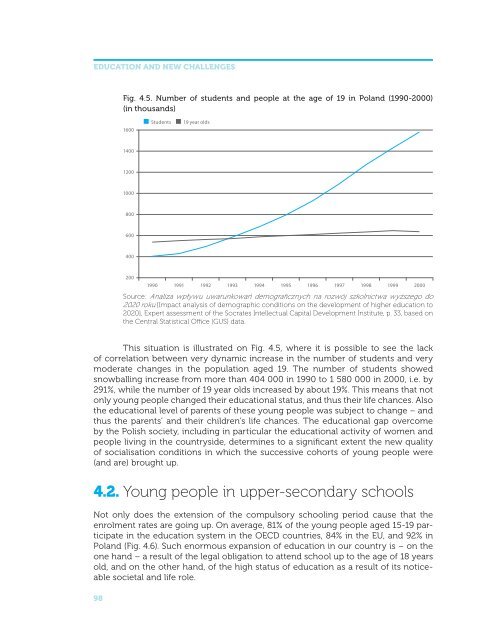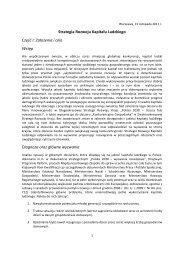Education and new challenges - Raport Polska 2030
Education and new challenges - Raport Polska 2030
Education and new challenges - Raport Polska 2030
Create successful ePaper yourself
Turn your PDF publications into a flip-book with our unique Google optimized e-Paper software.
<strong>Education</strong> <strong>and</strong> <strong>new</strong> <strong>challenges</strong><br />
Fig. 4.5. Number of students <strong>and</strong> people at the age of 19 in Pol<strong>and</strong> (1990-2000)<br />
(in thous<strong>and</strong>s)<br />
1600<br />
Students<br />
19 year olds<br />
1400<br />
1200<br />
1000<br />
800<br />
600<br />
400<br />
200<br />
1990 1991 1992 1993 1994 1995 1996 1997 1998 1999 2000<br />
Source: Analiza wpływu uwarunkowań demograficznych na rozwój szkolnictwa wyższego do<br />
2020 roku [Impact analysis of demographic conditions on the development of higher education to<br />
2020], Expert assessment of the Socrates Intellectual Capital Development Institute, p. 33, based on<br />
the Central Statistical Office (GUS) data.<br />
This situation is illustrated on Fig. 4.5, where it is possible to see the lack<br />
of correlation between very dynamic increase in the number of students <strong>and</strong> very<br />
moderate changes in the population aged 19. The number of students showed<br />
snowballing increase from more than 404 000 in 1990 to 1 580 000 in 2000, i.e. by<br />
291%, while the number of 19 year olds increased by about 19%. This means that not<br />
only young people changed their educational status, <strong>and</strong> thus their life chances. Also<br />
the educational level of parents of these young people was subject to change – <strong>and</strong><br />
thus the parents’ <strong>and</strong> their children’s life chances. The educational gap overcome<br />
by the Polish society, including in particular the educational activity of women <strong>and</strong><br />
people living in the countryside, determines to a significant extent the <strong>new</strong> quality<br />
of socialisation conditions in which the successive cohorts of young people were<br />
(<strong>and</strong> are) brought up.<br />
4.2. Young people in upper-secondary schools<br />
Not only does the extension of the compulsory schooling period cause that the<br />
enrolment rates are going up. On average, 81% of the young people aged 15-19 participate<br />
in the education system in the OECD countries, 84% in the EU, <strong>and</strong> 92% in<br />
Pol<strong>and</strong> (Fig. 4.6). Such enormous expansion of education in our country is – on the<br />
one h<strong>and</strong> – a result of the legal obligation to attend school up to the age of 18 years<br />
old, <strong>and</strong> on the other h<strong>and</strong>, of the high status of education as a result of its noticeable<br />
societal <strong>and</strong> life role.<br />
98







